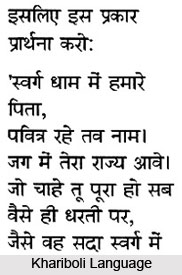 Khariboli, also known as Khadiboli or Khari, which literary means standing dialect, is a Western Hindi vernacular language spoken generally used in the rural regions of Delhi, Western Uttar Pradesh and southern Uttarakhand. Khariboli is believed to be the chief dialectical precursor of the Hindi-Urdu prestige dialect. Standard Hindi and Urdu, official standard registers and literary styles are the main official languages of India. Khariboli is supposed to have originated along with Braj and Awadhi dialects, during the same period, 900-1200 CE. Khariboli consists of various characteristics like germination that provides a unique sound and separates it Awadhi, Braj and standard Hindi-Urdu. Although Standard Hindi-Urdu and Khariboli are rather different in dialect, still Hindi-Urdu is often referred to as Khariboli and believed to be the literary form of the language.
Khariboli, also known as Khadiboli or Khari, which literary means standing dialect, is a Western Hindi vernacular language spoken generally used in the rural regions of Delhi, Western Uttar Pradesh and southern Uttarakhand. Khariboli is believed to be the chief dialectical precursor of the Hindi-Urdu prestige dialect. Standard Hindi and Urdu, official standard registers and literary styles are the main official languages of India. Khariboli is supposed to have originated along with Braj and Awadhi dialects, during the same period, 900-1200 CE. Khariboli consists of various characteristics like germination that provides a unique sound and separates it Awadhi, Braj and standard Hindi-Urdu. Although Standard Hindi-Urdu and Khariboli are rather different in dialect, still Hindi-Urdu is often referred to as Khariboli and believed to be the literary form of the language.
The application of the term Khariboli is still used in the same manner as it was applied traditionally, but lately, experts and linguists believe that the term Kauravi can also be applied to the dialect that is spoken in the Khari-speaking areas, particularly from Agra to Saharanpur.
History of Khariboli
Khariboli was considered as a higher standard of Hindi dialect as Delhi was regarded as the administrative center in northern India, during the 19th century. During the 1800s, in the Fort William College of Calcutta (now Kolkata), professors were encouraged to write in their vernacular languages. Some of the notable literary works are Naasiketopaakhyan, Premsagar, Rani Ketaki ki kahani, Sukhsagar etc. some other average literatures include, Yogavashishtha, Chand Chhand Varnan Ki Mahima, Mandovar ka varnan and others. After India`s independence Khariboli was recognized as an official language and an approved version of Hindi.
Distribution of Khariboli
Khariboli is mostly used in the rural regions of Delhi, Uttarakhand, Uttar Pradesh and Haryana. In Uttarakhand, the districts of the Yamuna-Ganges doab that partially speak Khariboli are Dehradun and Haridwar. In Uttar Pradesh, the dialect is normally used in Muzaffarnagar, Meerut, Bulandshahr, Saharanpur, Baghpat and Ghaziabad. In the Rohilkhand region of Uttar Pradesh, the districts of Jyotiba Phule Nagar, Moradabad, Bijnor and Rampur, also speak the language. Where as, Yamuna Nagar in Haryana is a partial Khariboli speaking region.
Features of Khariboli
The vowel length, accordant germination, differing verb-forms and limited loss of aspiration of Khariboli, portrays the dialect as separate from Standard Hindi-Urdu in the modern era. There are few vocabulary dissimilarities with the Hindi-Urdu dialect as well. Many words have distinct in Khari and Standard Hindi-Urdu.
Although, Khariboli was considered as a mixed unworthy and rustic language, but with government`s support, it has developed and thrived, as other older languages, like Brij, Avadhi, Maithili, have almost disappeared.



















